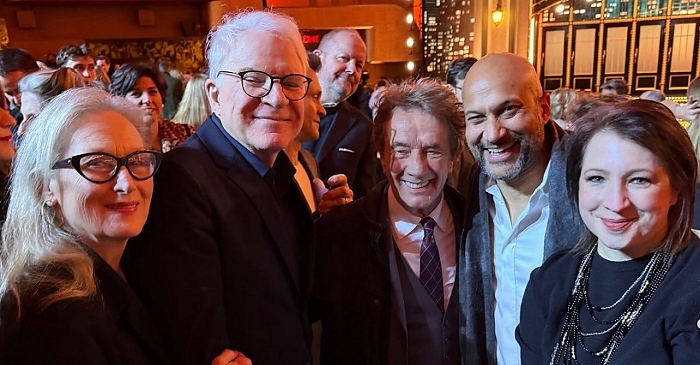|
Simply Streep is your premiere source on Meryl Streep's work on film, television and in the theatre - a career that has won her the praise to be one of the world's greatest working actresses. Created in 1999, we have built an extensive collection to discover Miss Streep's body of work through articles, photos and videos. Enjoy your stay.
|
Celebrating
25 years
of SimplyStreep
|
|
Meryl Streep's got legs
USA Today ·
September 12, 2009
· Written by Rachel Abramowitz
|
After years of critical acclaim, she is finally winning wide popularity and box office gold, at the age of 60. Her last nine movies have taken in almost $1.2 billion worldwide. Pop quiz: Over the last three years, which A-list actress has become a potent force at the box office, starring in a string of films that have taken in almost $1.2 billion worldwide? Is it Angelina Jolie? Reese Witherspoon? Kate Winslet? Or Sandra Bullock? If you answered “none of the above,” then you are probably already clued in to what has become one of the more surprising success stories to hit Hollywood in quite sometime. Need a hint? She turned 60 in June.
Yes, Meryl Streep, she of the multitudes of Oscar nominations, has for the first time in her career become genuinely popular, at a time when most of her female peers have been shoved into early quasi-retirement, and even slightly younger male cohorts, such as Kevin Costner and Bruce Willis, are shedding commercial viability as fast as their hair. Streep, once famed for playing a suffering Holocaust victim (“Sophie’s Choice”) and chilly ex-wives (“Manhattan” and “Kramer vs. Kramer”) is now best known to audiences of all ages for eating young fashion assistants for breakfast in “The Devil Wears Prada,” enthusiastically jumping up and down on a bed, wearing overalls and singing Abba tunes in the $600-million smash hit “Mamma Mia,” and trilling happily in Julia Child’s distinctive voice in this summer’s “Julie & Julia.” It’s been a grim year for the A-list. Many recent expensive star vehicles have fizzled at the box office, including Adam Sandler’s “Funny People,” Will Ferrell’s “Land of the Lost,” Russell Crowe’s “State of Play” and “The Taking of Pelham 123,” which starred John Travolta and Denzel Washington. Even Julia Roberts’ “Duplicity,” with Clive Owen, failed to connect with moviegoers. And now, for the first time in two decades, the industry is seriously re-evaluating movie-star worth and applying downward pressure to actor paydays. Yet Streep has not only survived but prospered. In the face of the summer’s typical onslaught of teenage-boy- oriented whammies and explosions, she’s gaily offered character and panache, going full tilt after the usually-ignored female audience. In the last three years, she’s mixed up the menu, jetting from comedies to musicals to biopics, with a stopover at classic Oscar fare. Unlike Nicolas Cage or Robert De Niro, who seemed to have consigned their credibility when they went ultra-commercial in films such as “Con Air” and “Analyze This,” Streep remains a perennial Oscar darling, nominated (yet again) last year for her turn as the tough but protective nun in “Doubt.” Although she is not bullet-proof commercially (the art house films “Evening” and “Dark Matter” both sank quietly), Streep has finally shed her elite air. She is no longer a figure more admired than beloved, and has become a movie star for the masses. “She’s found the right hybrid that mixes her dramatic and comedic skills,” says David Frankel, who directed her as the steely fashion editor in the 2006 hit “The Devil Wears Prada.” “There’s a warmth to her performances now that I think maybe wasn’t there earlier in her career. There’s also a joy to her performances. In ‘Julie & Julia,’ she’s downright giddy.”
“We don’t have to worry about her suffering any more,” says film historian Jeanine Basinger, referring to her penchant for painful roles. “It looks as if she’s matured to a point that very few actresses get to, arriving at the ‘Hell, I don’t really care anymore’ place. She’s not afraid to be mean or hated. She’s not afraid to be unglamorous. She’s more at ease with it. It looks like she’s over the career part and just having fun with the roles. That energizes everything she’s done.” The list of actresses who enjoyed careers spanning multiple decades is not a particularly long one: Joan Crawford, Bette Davis, Katharine Hepburn for example, all stayed in the spotlight for close to 50 years or more. But the number of actresses who experience a commercial resurgence during their third decade on screen is even shorter, especially in this era of instant and often talentless YouTube celebrity. For many, Streep’s “presence in a film is an endorsement that says to the ticket buyers that you’re not going to be cheated,” Basinger says. “That is what stardom has come down to – value for your money.” “Mamma Mia” producer Gary Goetzman says, “There’s such respect out there for her, that when she does anything close to being a mainstream movie, she classes it up.” And as consumers yearn for comfort, reassurance and escape during this economic downturn, Streep has never been more appealing, says Jane Buckingham, a marketing consultant and expert in youth culture who has advised numerous studios. “We’re all sort of looking for that mother figure that we wish we had when times are tough, especially Generation X, who didn’t have the parents we wish we had.” Buckingham says the mother-daughter tale in “Mamma Mia” made Streep “relevant” to the under-25 set. Even as she does more mainstream fare, Streep remains exacting in her artistic standards, a perfectionist, notes Nora Ephron, director of “Julie & Julia,” recalling how the 5-foot-6 Streep insisted that she was going to be 6-foot-2 in the film, like the real Child. “I didn’t know how she was going to do it,” Ephron says. “For me, she didn’t have to be 6-foot-2. But for her, she had to be 6-foot-2. For me, she needed to be Meryl Streep playing Julia Child. But for Meryl, everything was about her height.” Until recently Streep was primarily known for her mastery of accents and dramatic sweep, but she did make a stab at comedies in the early 1990s, appearing in “Death Becomes Her,” “She-Devil,” and “Postcards from the Edge.” Dealing with topics such as plastic surgery and drug addiction, these comedies alienated some of her core constituency.
“A lot of it was painful comedy, very punishing for the female presences,” Basinger says. Streep declined to comment for this article, but last year pointed out that three of her four latest movies (“Mamma Mia”, “Julie & Julia”, and the upcoming comedy “It’s Complicated”) were directed by women, and all her box-office hits were championed by female movie executives or producers. “People operate on instinct and they do things that kind of make them feel good on some level, and so every time we complain there’s not enough things for women, that’s because the people that are making the decisions are not turned on by material we are,” Streep said. “It’s a very simple equation.” Many of Streep’s recent hits have opened solidly but not spectacularly, then kept chugging along, bucking the trend of movies making the majority of their money in the first weekend (her movies have “legs,” to use the industry parlance, indicating positive word of mouth from audiences after they leave the theater). “Julie & Julia,” which has Oscar prognosticators seeing a nomination for Streep, had a $20-million opening weekend and has earned $82 million domestically so far (it will continue rolling out around the world this fall). With the exception of “It’s Complicated,” with a budget of $75 million, Streep’s films have tended to be moderately priced (“Julie & Julia” was made for about $40 million), and her reported $7 million to $8 million salary is about half of what actresses such as Jolie or Witherspoon can command, let alone the top male stars. But with her four children largely grown, Streep has also been working more frequently than many of her younger peers who are juggling child care with movie work. “She’s always been the most highly decorated actress of our time, but there’s real artistic freedom that comes with enormous box-office success,” director Frankel notes. “For years, she played opposite all these male movie stars who made fortunes, and now suddenly at age 60, she cashed in, not because she went out and did action movies, but she scored doing movies she loved and embraced.
“That power is liberating.”









